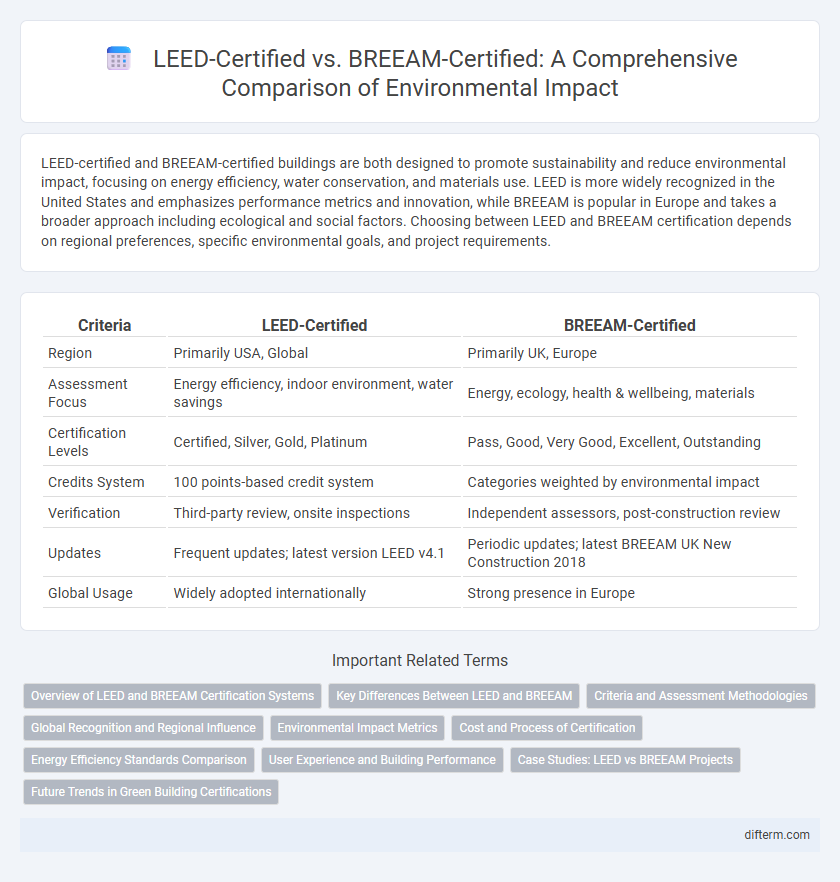LEED-certified and BREEAM-certified buildings are both designed to promote sustainability and reduce environmental impact, focusing on energy efficiency, water conservation, and materials use. LEED is more widely recognized in the United States and emphasizes performance metrics and innovation, while BREEAM is popular in Europe and takes a broader approach including ecological and social factors. Choosing between LEED and BREEAM certification depends on regional preferences, specific environmental goals, and project requirements.
Table of Comparison
| Criteria | LEED-Certified | BREEAM-Certified |
|---|---|---|
| Region | Primarily USA, Global | Primarily UK, Europe |
| Assessment Focus | Energy efficiency, indoor environment, water savings | Energy, ecology, health & wellbeing, materials |
| Certification Levels | Certified, Silver, Gold, Platinum | Pass, Good, Very Good, Excellent, Outstanding |
| Credits System | 100 points-based credit system | Categories weighted by environmental impact |
| Verification | Third-party review, onsite inspections | Independent assessors, post-construction review |
| Updates | Frequent updates; latest version LEED v4.1 | Periodic updates; latest BREEAM UK New Construction 2018 |
| Global Usage | Widely adopted internationally | Strong presence in Europe |
Overview of LEED and BREEAM Certification Systems
LEED-certified buildings adhere to the U.S. Green Building Council's framework emphasizing energy efficiency, water savings, and indoor environmental quality, while BREEAM certification, developed by the UK Building Research Establishment, assesses environmental, social, and economic sustainability across broader criteria including land use and ecology. Both systems provide comprehensive rating methods but vary in regional applicability, with LEED widely used across North America and BREEAM dominant in Europe and international markets. Projects targeting LEED certification focus on quantitative performance metrics, whereas BREEAM incorporates both qualitative assessments and stakeholder engagement for holistic sustainability evaluation.
Key Differences Between LEED and BREEAM
LEED-certified projects primarily emphasize energy efficiency, water savings, and indoor environmental quality using a point-based system focused on American building standards. BREEAM-certified buildings incorporate a broader range of sustainability factors including ecological impact, management processes, and health and wellbeing, reflecting European environmental regulations. LEED scores range from Certified to Platinum, while BREEAM ratings span from Pass to Outstanding, each with distinct criteria tailored to their regional climates and building practices.
Criteria and Assessment Methodologies
LEED-certified projects are assessed using a point-based system that evaluates energy efficiency, water usage, indoor environmental quality, and sustainable site development, emphasizing performance metrics and documentation. BREEAM-certified projects apply a tailored scoring framework based on categories such as energy, health and wellbeing, pollution, transport, materials, waste, water, land use, and ecology, incorporating both prescriptive and performance-based measures. Both certification systems utilize independent verification processes, but LEED mainly relies on third-party documentation review while BREEAM includes on-site assessments and post-construction evaluations for comprehensive sustainability analysis.
Global Recognition and Regional Influence
LEED-certified buildings benefit from widespread global recognition, with strong influence in North America, the Middle East, and parts of Asia, reflecting its comprehensive sustainability standards and adaptability to diverse climates. BREEAM-certified projects hold significant regional influence in Europe, especially the UK, where its tailored assessment criteria align closely with local environmental policies and building regulations. Both certifications promote sustainable construction but are chosen based on geographic relevance and regional market acceptance.
Environmental Impact Metrics
LEED-certified buildings emphasize energy efficiency, water use reduction, and indoor environmental quality, using metrics such as Energy Star scores and GHG emissions to gauge environmental impact. BREEAM-certified projects prioritize a broader range of sustainability factors, including biodiversity, pollution control, and materials sourcing, measured through weighted environmental impact scores and lifecycle assessment data. Both certification systems use rigorous performance benchmarks but differ in their approach to quantifying resource efficiency and ecological footprint in green building design.
Cost and Process of Certification
LEED-certified buildings typically incur higher upfront costs due to stringent energy performance requirements and comprehensive documentation, yet offer long-term savings through enhanced operational efficiency. BREEAM-certified projects often have a more flexible certification process with lower initial fees, emphasizing tailored sustainability criteria adaptable to regional standards. The certification timeline for LEED is usually longer because of rigorous verification stages, while BREEAM's modular assessment allows faster completion and incremental certification.
Energy Efficiency Standards Comparison
LEED-certified buildings prioritize energy efficiency through a points-based system that rewards sustainable site development, water savings, and indoor environmental quality, often achieving up to 30-50% energy savings compared to standard buildings. BREEAM-certified projects assess energy performance with stricter benchmarks tied to regional climate and building regulations, emphasizing lifecycle energy consumption and operational carbon emissions reduction. Both certifications drive substantial improvements in energy efficiency, but BREEAM often integrates more comprehensive local environmental factors, while LEED provides a globally recognized framework adaptable to various building types.
User Experience and Building Performance
LEED-certified buildings prioritize energy efficiency and indoor air quality, enhancing occupant comfort and reducing operational costs through advanced HVAC systems and sustainable materials. BREEAM-certified structures emphasize comprehensive environmental management and long-term building performance, resulting in improved thermal comfort and resource efficiency tailored to regional climates. Both certifications improve user experience by fostering healthier indoor environments and optimizing building functionality for sustainable operation.
Case Studies: LEED vs BREEAM Projects
LEED-certified projects often emphasize energy efficiency and indoor environmental quality, demonstrated in high-profile buildings like the Bank of America Tower in New York, achieving advanced sustainability metrics. BREEAM-certified projects, such as the Bloomberg European Headquarters in London, prioritize comprehensive environmental impact assessments and lifecycle sustainability, showcasing robust performance in water usage, carbon footprint, and waste reduction. Comparative case studies reveal LEED's strength in operational energy savings, while BREEAM excels in evaluating broader ecological impacts, influencing project selection based on regional environmental goals.
Future Trends in Green Building Certifications
LEED-certified projects increasingly integrate advanced energy analytics and occupant well-being metrics, reflecting growing demands for smart, health-focused buildings. BREEAM-certified developments emphasize circular economy principles and lifecycle assessments to reduce environmental impact throughout a building's lifespan. Both certification systems are evolving to prioritize carbon neutrality and resilience against climate change, driving innovation in sustainable construction practices.
LEED-certified vs BREEAM-certified Infographic

 difterm.com
difterm.com